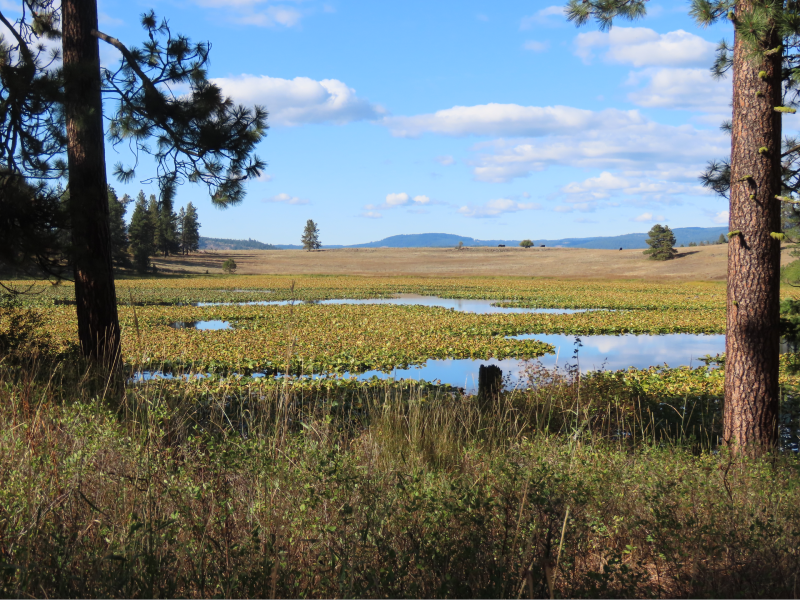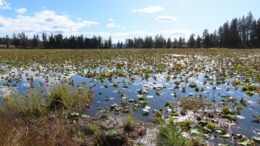The Place:
Atop a ridge in the Blue Mountains, just west of the small town of La Grande in northeast Oregon, hides a beautiful small lake and associated wetland. What we now call Twin Lake or Little Morgan Lake — its Indigenous name is unknown to me — offers the promise of secluded summer breeding habitat for aquatic species, as well as food and respite for many birds following ancient migration routes. Clean, perennial water supports a complex community of aquatic plants, invertebrates and amphibians.
Why it matters:
Twin Lake hides behind its larger sister, Morgan Lake, on Glass Hill. Construction of a small dam in the early 1900s increased the size and depth of Morgan Lake, creating a reservoir for irrigation and, soon thereafter, electrical power. Water released from the dam tumbled down 1,000 feet, passing through turbines to generate electricity for the growing town below. Twin Lake, however, escaped development and remains a place of peaceful natural beauty.
By the 1960s local power no longer depended on the dam, and Morgan Lake reservoir appeared to be doomed to become an exclusive, gated development of waterfront homes. Against long odds, a dedicated group of local conservationists affiliated with the Isaak Walton League helped to forestall this plan. The lakes and remaining wetlands were deeded to the city of La Grande in 1967, providing some measure of protection for native vegetation, wildlife, and recreation.
Today the city of La Grande owns and manages the property as Morgan Lake Park. Stocked with fish each summer, Morgan Lake attracts boaters, fishers and picnickers. Twin Lake, though part of the park, has largely escaped public attention. Somewhat hidden to the west, it remains in near pristine condition, where it provides refuge for an extraordinary diversity of emergent aquatic plants, invertebrates, reptiles, amphibians, and countless seasonal nesting birds and annual migrants.
These ridgetop wetlands harbor secrets of some ancient geologic magic. No inlet stream enters either lake, yet both Twin and Morgan lakes remain wet year-round. Subterranean springs pump water upward from an active aquifer hidden somewhere below. Snowmelt also contributes moisture to the system.
Twin Lake comprises a broad, shallow pond filled with emergent plants that exhibit surprising botanical diversity. A lush growth of native great yellow pond-lilies (Nuphar polysepala) thrust their large flowers up through dense mats of floating leaves. Common bladderwort (Utricularia vulgaris) catches and digests tiny insects and crustaceans in trapdoor bladders hidden among their leaves submerged beneath the water. An unusual plant known as bogbean (Menyanthes trifoliata), found nowhere else along Glass Hill, flourishes in Twin Lake.
The threat:
Idaho Power Company has applied for a permit to construct a 500-kilovolt power line that would run through the property directly adjacent to Twin and Morgan Lakes. Following official condemnation of the surrounding private lands, deep blasting will commence in order to set the footings prior to construction of immense towers. In addition to a higher wildfire threat from the high-voltage lines, construction and operation of the power line will introduce invasive plant species and possibly alter the area’s hydrology irreparably.
The underlying geology of Glass Hill is complicated and not well understood. No one knows exactly how the flow of subterranean water to Twin and Morgan Lakes might be altered by tower construction. Without life-sustaining spring water, Twin Lake may dry up quickly, leaving behind only a dry, fire- and weed-prone field of little ecological value.
My place in this place:
The origin story of Glass Hill includes explosive volcanic eruptions, lava flows from ancient fissures in the underlying rock, and faults thrusting layers of basalt upward in seismic events buried in long, geologic time. Next, layers of fine volcanic ash spewing from the great eruptions of Mt. Mazama 7,700 years ago added layers of fertile soil throughout the forests of northeast Oregon. Indigenous people walked this ridge for many thousands of years, creating their stories and life histories in harmony with the land. People from the Cayuse, Umatilla, Walla Walla and Nez Perce Tribes arrived to harvest abundant camas bulbs and fish in the Grande Ronde Valley below.
Eventually wagon trains following the Oregon Trail westward from Missouri brought many new people to this place, including some of my own ancestors. Changes to the landscape were profound, as farming, mining and railroads replaced sustainable hunting and gathering. As a botanist, I grieve the many losses and acknowledge that what remains is precious.

Innumerable stories could be told about the complex web of interactions of any native ecosystem. These stories inform the collective wisdom and experiences of the communities they embrace. Our lives, like those of Indigenous people before us, become impoverished when these connections disappear from living memory. I feel protective of this place and have sought to keep knowledge of the natural ecosystems alive through public education. The unique wetlands springing to life along this obscure ridge top might continue to fill us with wonder and inspiration for many more generations, if we can only keep it whole.
Who’s protecting it now:
Twin Lake has no official protection beyond its inclusion within Morgan Lake Park. A grassroots organization, the Stop B2H Coalition, has formed in opposition to the transmission line, which will run 305 miles and require 1,200 towers.
What this place needs:
Strong environmental protection ultimately requires time, money, political savvy, and sustained community involvement. The economic forces driving big energy projects like this one quickly overwhelm small communities. Twin Lake needs the legal protections that a strong conservation easement might provide. Legal documents require attorneys. Attorneys require fees. Fundraising requires dedicated volunteers, donors, and an engaged community.
Lessons from the fight:
We must practice constant vigilance. Concerned residents and the Isaak Walton League helped save this area once before from commercial development. We became complacent, assuming that this special, peaceful place would always be here for morning birdwatching, afternoon walks, and summer star-gazing. No one ever imagined that the day would come in which the very existence of this important wetland would be threatened by construction of high-voltage electrical power lines. Special places require special protections, and once the threat appears, it may be too late.
Get more from The Revelator. Subscribe to our newsletter, or follow us on Facebook and Twitter.
Previously in The Revelator:
Protect This Place: Kenya’s Kinangop Grasslands
![]()


